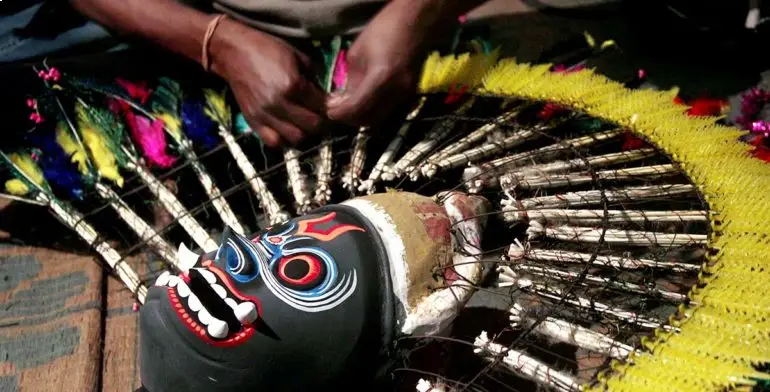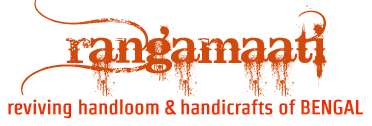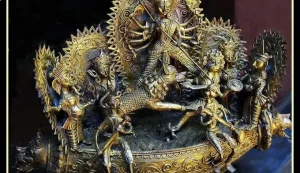
Mask or mukhosh as it is known in Bengal has a mysterious history, too vague to be chronicled in perfect sequence, both in terms of advent and influence. Rumour has it that in ancient times, witches started the practice of wearing masks. To camouflage themselves, the witches built a sublime weapon, a facial veil that prevented them from being exposed. They wore colourful ornate faces made from wood or paper, a bait to attract innocent people who were then sacrificed so that the witches would be granted immortality.
There are various theories regarding the origin of masks in Bengal – one of them says that the wearing of masks started during the time of the great migration that took place in the Bengal delta during pre-historic times; another associates masks with symbols of negating geo-political boundaries of the world.
Though there is considerable ambiguity about the origin of masks in Bengal, it is evident that masks were of great religious importance owing to the belief in spells. Tribal priests would wear these masks and exhibit various magic skills.
Thus masks became a popular prop in Bengali culture, many of them being used in various dance forms performed to appease the demon gods and to usher in peace as well as prosperity.

Masks & Emotions:
The masks of Bengal are acclaimed for their craftsmanship and bears lot of emotions and sentiments.For instance the Gamira mask, which is the ecstatic wooden mask of Kushmandi primarily associated with the Rajbangshi community of the area, is an essential part of the Gamira dance performed in the northern parts of the state. This mask is used to depict various epic characters of animals such as the tiger and deer as well as of gods and goddesses to act out mythological stories that are the main theme of this dance. Popularly known as ‘Mukha Khel’, meaning the game of masks, this particular dance form is dedicated to Gramchandi, believed to be the saviour of a village. Similarly in other local ritualistic dances like Gambhira or Bagpa we find significant use of masks,all establishing the fact that the ancient world treated masks as instruments of revelations, a pathway to the world of gods and other invisible powers, by giving form to the formless.
Though primarily, masks were made for religious functions, folk theatre and folk dance, they held a special significance in other facets of regular life. Owing to its multifarious uses, the kinds of masks in vogue are diverse, each fulfilling a particular purpose or function. So while the shola (sponge wood) masks are often used to decorate a deity, especially the mother goddess, the terracotta or the Dokra masks are used for décor and as symbols to ward off an evil eye.
Prevailing Masks of Bengal
CHHAU DANCE MASKS OF PURULIA.
SHOLA (SPONGE WOOD) MASKS.
KUMARTULI’S CLAY MASKS.
MASKS OF THE BAGPA DANCE.
DOKRA MASKS.
GHAMBHIRA MASKS
GILDED MASKS.
RABANKATA MASKS.
MAHIRABAN MASKS.
BANABIBI PALA MASKS.
CLAY MASKS OF GHURNI.
GAMBHIRA DANCE MASKS.
SHIKNIDHAL MASKS OF KUSHMUNDI.
SHOLA MASKS FROM MURSHIDABAD.
GHAMBHIRA MASKS:
The Gamira dance is performed in North and south Dinajpur districts. The word Gamira has originated from Gramchandi, believed to be the saviour of a village. Mythological stories are the theme of this dance and the use of masks is the special attraction. Masks of various epic characters, of animals such as the tiger and deer as well as of gods and goddesses are used in the dance. The scary masks of the Gamira are made from the wood of the Gamar tree. Holes are made under the eyes of the mask for the wearer to see.
————————————————————————————————–
MAHIRABAN MASKS:
Mahiraban, a mythical character in the epic Ramayana, is said to be the brother of the Lanka King Ravan. He is also known as ‘Patal Raban’. He did not take the side of Ravan during his war with Rama. But, Ravan deceived and compelled him to abduct Rama and Lakshmana. At last, Hanuman, the monkey god, killed Mahiravan and rescued them. This tri-headed wooden mask is used in the Gamira dance form of South Dinajpur.
————————————————————————————————–SHOLA (SPONGE WOOD) MASKS:
Sponge wood masks are used in the ancient Gamira dance of North Dinajpur. The artisan first prepares a model from mashed paper. A piece of cloth soaked in mud water is layered upon. When dry, it is topped by sponge wood and coloured. Powdered colours from the market are mixed with water and applied. To add a glow to the mask, it is given a varnish polish. In the end, it is decorated with
sequences, foil, and coloured paper.
————————————————————————————————–SHIKNIDHAL MASKS OF KUSHMUNDI:
Another gigantic wooden mask used in the Gamira dance of South Dinajpur is the Shiknidhal mask.The Shiknidhal mask is used in the war dance.Since the dance is performed wearing masks, itis also called ‘Mukha Khel’ meaning the game of
masks.
————————————————————————————————–GAMBHIRA DANCE MASKS :
The Gambhira dance is performed during the festival of Chaitra Sankranti all over Malda district of North Bengal. It is a solo dance revolving around mythological characters. The masks used in this dance are made out of neem and fig trees by the local Sutradhar community. They were also sometimes made of clay. The three-dimensional crowns are the specialty of these masks. First, the facial features are carved out from a piece of wood and then coloured according to the character.
————————————————————————————————–CLAY MASKS OF GHURNI :
The Ghurni region of Krishnanagar in Nadia district has been a notable centre of clay art for a long time. Its popularity lies in the colourful, firedclay dolls. For the last few years, the artisans in this area have started experimenting. These masks follow a contemporary style. These masks have been developed by Biswa Bangla for home decor.
————————————————————————————————–DOKRA MASKS :
Metal casting by the lost wax process known as Dokra is a unique folk art of West Bengal. Female artist Gita Karmakar of Bankura has created various contemporary sculptures with this art form.She has also been awarded the President’s award.Her works of Dokra art are equally popular in other countries. To enhance the durability of these artpieces, the metal is specially polished. Gita has also been praised for her range of Durga statues. These dokra masks have been developed by Biswa Bangla from traditional dokra artefacts for home decor.
————————————————————————————————–GILDED MASKS :
This ecstatic wooden mask, from Kushmundi in the district of Dakshin Dinajpur, West Bengal, is part of the costume of the traditional Gamira dancers.The themes of the masks are generally historic or religious. Bamboo and wood are used to make these masks which weigh around 2.5 to 3 kg. A soft wood called gamari is used to make the masks so that it can be easily chiselled into intricate designs. Themask is then covered with exquisite Italian gold leaves hammered into thin sheets.
————————————————————————————————–
SHOLA MASKS FROM MURSHIDABAD :
Shola or sponge wood has been used by various artists all over West Bengal. It is also used to decorate statues. The Durga face is well known. The shola is pulled out from the water and dried. It is then cut according to the design with a knife. Murshidabad district in West Bengal is recognized for its shola work.
————————————————————————————————–KUMARTULI’S CLAY MASKS :
Kolkata’s Kumartuli is well-known for its statues.The statues are made in clay and then sun-dried.They are finally coloured and decorated with sponge wood or foil. China Pal has been receiving a lot of attention for sculpting Bengali deities.
————————————————————————————————–MASKS OF THE BAGPA DANCE :
The Bagpa dance is a part of tantrik Buddhism and was conceptualized by Guru Padmashambhu (Guru Rimparche). It’s a war dance based on the theme of the destruction by evil and for the well-being of humanity. Various colourful wooden masks, each for a different character, are crafted from wood. They are mainly coloured in red, blue and white. Other colours are used for detailing work. Bagpa is called Bagchham by the Buddhistguru lamas of Tamang. The Bagpa dance is also known as the Lama dance as they are performed by Buddhist lamas. Kajimal Golay, a well-known artist of Bagpa dance masks and a researcher, has set up the Dooars Museum and Research Centrefor the revival and spread of the dying arts of thecommunities living in the Himalayan region.
————————————————————————————————–
BANABIBI PALA MASKS :
The Banabibi pala (a short play) is a highly popular folk-theatre of the Sunderban region. The theme is the conflict between Banabibi, the guardian spirit of the forests and Dakshin Ray, a demon king. Banabibi is venerated by both the Hindu and the Muslim residents of the Sundarbans (spread across West Bengal state in eastern Indiand Bangladesh). In the end, Banbabi emerges victorious over the wicked Dakshin Ray. She is called upon mostly by the honey-collectors and the woodcutters before entering the forest forprotection against the attacks from
the tigers.It is believed that Dakshin Rai (the lord of the south) actually appears in the disguise of a tigerand attacks human beings. Earlier, the play was performed in the light of lanterns but, now bright costumes and musical instruments have added to the spectacle. The main attractions of this skit are the masks of the tiger and crocodile.
————————————————————————————————–CHHAU DANCE MASKS OF PURULIA :
‘Chhau’, which means fun and frolic, is a dance of the hardworking population of Purulia. The Chhau dance is performed during the festival of Chaitra Sankranti’. Earlier, the tales relating to the deities used to be the theme of the dance. Today, various social issues are part of the dance too. Chhau is a dance of the brave hearts, a dance of war, where the mask is an inseparable part. These world famous masks are made by the artists from the Sutradhar community. The making of a mask goes through various stages. After the mud mould is dusted with fine ash powder, 8-10 layers of soft paper, immersed in diluted glue, are pasted one after another on the mould. The facia features are made with clay. A special layer of mud and cloth is then applied and the mask is sundried. After this, the mould is polished and a second round of sun drying is done before separating the layers of cloth and paper from the mould. After finishing and drilling of holes for the nose and eyes, the
mask is coloured and decorated.
————————————————————————————————–RABANKATA MASKS :
The dance using this mask is performed during Durga Puja in Bishnupur of Bankura district. The theme is the victory of good over the evil. Here Goddess Durga stands for the ‘good’ that destroys the evil Ravan. This dance form started between 1626 and 1656 B.C. This dance form uses six masks: while the first four are used directly in the dance, the other two are absolutely ritualistic.





